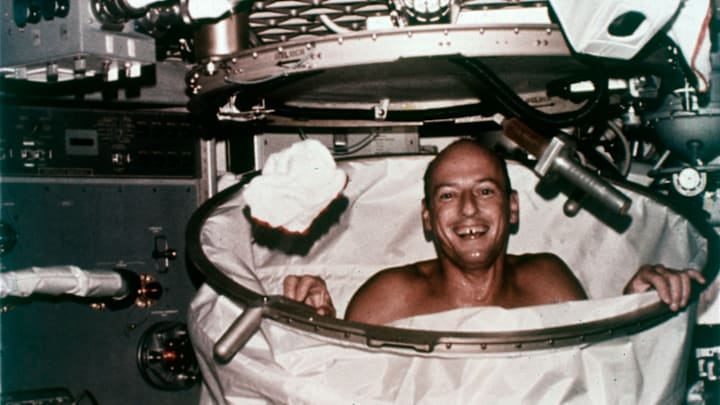Here on Earth, we tend to take showers for granted. But for astronauts stationed in space, taking a quick rinse—much like cooking, eating, using the toilet, and just about every other mundane, everyday task—becomes a lot more complicated due to the near-absence of gravity.
On Earth, gravity keeps our pans on the stove, food on our plates, and water falling from the shower head in a straight, uninterrupted line. In space, on the other hand, water not only floats around like dust but also sticks to itself due to surface tension, forming bubbly spheres that are every bit as mesmerizing to watch as they are ill-suited for washing.
Before space expeditions came equipped with their own filtration systems, astronauts had to conserve as much water as possible. Crew members on NASA’s Gemini and Apollo missions, which took place during the 1960s, opted for sponge baths, cleaning themselves with soap and towels just as one would on Earth, only a bit more laboriously.

To make the astronauts feel more at home in orbit, Skylab—the first U.S. space station—came equipped with a contraption more closely resembling a shower [PDF]. A floor-to-ceiling, cylinder-shaped tarp acted as a shower curtain to prevent water from escaping, and a nitrogen-pressurized water bottle functioned as a shower head, substituting propelling force for gravity.
Although some astronauts appreciated the space shower, most found it impractical and cumbersome (the average shower time reportedly lasted over two hours). As a result, Skylab’s successor, the International Space Station, ended up reverting back to sponge baths, with astronauts cleaning themselves using rinse-free soap and shampoo.
Where Skylab astronauts relied primarily on pre-loaded water tanks, the ISS is equipped with a filtration system that captures the moisture that evaporates from astronauts’ hair and bodies and turns it into clean drinking water. The system also filters moisture from the astronauts’ breath, as well as their urine. In all, 80 percent of the ISS’s water supply (530 gallons in total) is recycled.
“A Glob of It Will Go Flying Off”
Living in a microgravity environment doesn’t mean you don’t sweat. Astronauts perspire just as much as us earthlings do. Worse, sweat, like water, sticks to their bodies, clumped into spheres and held together by surface tension. “You have pools of sweat on your arms, your head, around your eyes,” astronaut Mike Hopkins, who was stationed at the ISS from September 2013 to March 2014, wrote in The Atlantic. “Once in a while, a glob of it will go flying off.”
Unfortunately, no matter how thoroughly astronauts clean themselves, the ISS’s facilities are unable to rival the efficiency of bathrooms down on Earth. While space itself is a vacuum and therefore devoid of odors, which travel to our nostrils by way of oxygen, the interior of space stations and exploration vehicles are said to smell like a combination of antiseptic, garbage, gunpowder, barbeque, and BO.
Even with modern toiletries, the inside of the ISS probably smells similar to the earliest crewed spaceflights, as today’s astronauts wash themselves in the same manner as those in the 1960s.
“The [Gemini and Apollo] astronauts had been in their suits so long without changing their clothes that the scent lingered the entire time,” said Jennifer Levasseur, a curator in the Smithsonian’s National Air and Space Museum’s Space History Department. “It was a slap in the face to those who greeted them upon their return because the scent was so strong.”
Read More Fascinating Facts About Space Exploration:
